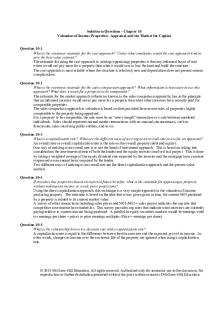Review for Chapter 10 PDF

| Title | Review for Chapter 10 |
|---|---|
| Author | Israel Suarez |
| Course | Critical Thinking |
| Institution | The University of Texas Rio Grande Valley |
| Pages | 2 |
| File Size | 48.7 KB |
| File Type | |
| Total Downloads | 64 |
| Total Views | 180 |
Summary
chapter review...
Description
Review for Chapter 10 1. Distinguish between race and ethnicity. How do dominate and subordinate groups differ from majority and minority groups? What is colonialism? Provide an example. Race is the division of people based on physical characteristics. Ethnicity is the classification of people who share a common cultural, linguistic or ancestral heritage. Majority groups are groups that have the largest population and holds a significant amount of power and privilege. Minority groups are groups that has a smaller population and less power than the majority group. A dominant group is the group that has the greatest power but not the greatest numbers. Colonialism is a system in which more powerful countries impose their will on weaker nations 2. How many definitions of race are included in the U.S Census form? How are Hispanics classified?
3. What is racism? What are the assumptions about racism? What is an extreme form of racism called? Provide an example of a hate group. 4. What Supreme Court decision made segregation in public schools unconstitutional? (Look this up) Brown v. Board of Education of Topeka, 5. What are the different patterns of interaction? Know examples for each pattern Migrant Superordination is the conquest of a native population by a more powerful group Ex: Spain dominating the native population in South America Indigenous Superordination is subordination of an immigrant group to a dominant group Ex: Immigrants in U.S. are expected to learn English 6. Define the concepts of prejudice and discrimination and discuss how they are related to each other. Explain how stereotypes contribute to prejudice thinking. Prejudice refers to negative attitudes about an entire category of people. Prejudice is often reinforced by stereotypes: simplified perceptions people have of an entire category of people. Discrimination is the unfair treatment of npeople based on prejudice Discrimination is an action that stems from the attitude of prejudice Institutional discrimination maintains the advantage for the dominant group, while providing the appearance of fairness to all 7. What are the causes for prejudice and discrimination?
Because we do not have the ability to attach the real source of our frustration we select a scapegoat. Scapegoat is an unfair accusation against a person or group as the cause of a problem 8. Define segregation? What does the study on housing segregation done by Massey and Denton show? When discussing a “cycle of poverty,” how do racial and ethnic groups compare? What does the data show when comparing educational attainment by race and ethnic group? Segregation is forced separation because of factors such as race, gender or ethnicity. The cycle of poverty is a generational barrier that prevents poor people from breaking into middle and upper classes. 9. Provide an example of colorblind racism. Who expressed the concern for the existence of a “double consciousness.” What does this term mean? W.E.B Dubois suggested the idea of double consciousness which is a sense that a person must keep a foot – Color-blind racism suggests that we often ignore institutional discrimination that applies to minorities 10. Know Robert Merton’s Typology of prejudice and discrimination (see below)...
Similar Free PDFs

Review for Chapter 10
- 2 Pages

CH 10 Review - chapter 10
- 3 Pages

Chapter 10 Review - mmmm
- 2 Pages

Chapter 10 review questions
- 8 Pages

Chapter 10 Review
- 3 Pages

Chapter 10 - Review question
- 2 Pages

Summary - Chapter 10 review
- 1 Pages

Chapter 10 Review Questions
- 3 Pages

Chapter 10 Review Questions
- 4 Pages

Chapter 10 Review Genetics
- 4 Pages

Chapter 10 Review Questions
- 1 Pages

Quiz for chapter 10
- 12 Pages

Review Chapter 10 - Cijfer: 7
- 6 Pages

AHP Chapter 10 Review Questions
- 4 Pages
Popular Institutions
- Tinajero National High School - Annex
- Politeknik Caltex Riau
- Yokohama City University
- SGT University
- University of Al-Qadisiyah
- Divine Word College of Vigan
- Techniek College Rotterdam
- Universidade de Santiago
- Universiti Teknologi MARA Cawangan Johor Kampus Pasir Gudang
- Poltekkes Kemenkes Yogyakarta
- Baguio City National High School
- Colegio san marcos
- preparatoria uno
- Centro de Bachillerato Tecnológico Industrial y de Servicios No. 107
- Dalian Maritime University
- Quang Trung Secondary School
- Colegio Tecnológico en Informática
- Corporación Regional de Educación Superior
- Grupo CEDVA
- Dar Al Uloom University
- Centro de Estudios Preuniversitarios de la Universidad Nacional de Ingeniería
- 上智大学
- Aakash International School, Nuna Majara
- San Felipe Neri Catholic School
- Kang Chiao International School - New Taipei City
- Misamis Occidental National High School
- Institución Educativa Escuela Normal Juan Ladrilleros
- Kolehiyo ng Pantukan
- Batanes State College
- Instituto Continental
- Sekolah Menengah Kejuruan Kesehatan Kaltara (Tarakan)
- Colegio de La Inmaculada Concepcion - Cebu

